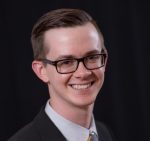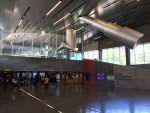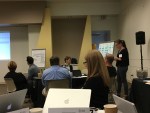

As a professional museum nerd, I can state for a fact that there is nothing more exciting than being in a room filled with other museum nerds–which is what makes AAM’s Annual Meeting and MuseumExpo so exciting. But every fall, long before people begin boarding planes to attend the annual meeting in its host city, a group of around 35 people gather to review, select, and make recommendations on sessions to be presented at the following year’s annual meeting.
The National Program Committee, on which I’ve had the pleasure of serving for two years now, is made up of museum professionals from across the country (and beyond), representing diverse professional expertise, regional affiliations, and types of institutions that have an overview of the entire museum field. This year committee members ranged from employees of relatively small historic sites like Historic Beverly in Beverly, MA, to consultants and leaders from institutions like the Minneapolis Institute of Art, National World War II Museum, and the Louisiana Children’s Museum. The group’s job is to serve as peer reviewers, reading and examining every single submitted proposal for the following year’s annual meeting (this year there were more than 400!), and determining what is or isn’t presented to the more than 4,000 museum professionals who attend every year. The job isn’t a small one—committee members spend nights and weekends ahead of the meeting reviewing, rating, and sharing comments on submitted proposals online before coming face to face at the National Program Committee gathering. Then, in a whirlwind two-day session, the

Committee members split into groups, re-review all proposals together, provide feedback on all sessions that aren’t accepted, and build the lineup of sessions to be presented at the next year’s Annual Meeting.
This year, the National Program Committee came together in Phoenix, AZ, the site of next year’s meeting, for their deliberations on October 5 and 6. While our days started early and ended late, we did have the chance to experience a little bit of Phoenix, exploring our host museum, the Arizona Science Center, and marveling over a.) the number of cacti dotting the landscape and b.) how HOT it was (apparently Autumn comes late to Phoenix!) The rest of our time was taken up by in-depth discussions as we considered each and every submitted proposal, some friendly arguments when we had to make hard choices on what proposals to accept and those that didn’t make the cut, and more than a few cups of coffee. At the end of the marathon meetings, we had established the session lineup for 2018, marveled over the exciting things happening in our field as demonstrated in the proposals, and headed back to our respective corners of the country.

If you submitted a proposal to this year’s annual meeting, we cannot thank you enough. You’ll hear back later this Fall on whether or not your submission has been accepted by the committee. But even if your proposal isn’t accepted, know that the time and effort you put into the proposal are recognized and appreciated by the National Program Committee. Also know that we want to hear from you again! Please consider submitting another proposal for the 2019 meeting in New Orleans—we can never have too many.
In that spirit, here are a few tips for what makes a strong proposal and what is often discussed around the table as the National Program Committee makes its decisions:
Follow the rules and fill in the boxes.
The submission system is built to include all of the relevant information the National Program Committee needs to consider a proposal, from presenter bios to descriptions and learner outcomes. These are important boxes to check, and leaving information fields blank, skipping sections, or providing barebones information makes it difficult for a proposal to succeed when going up against more detailed submissions.
Bring a diversity of voices to the table
Museum professionals love hearing from you and your institution, but what they love even more is also being able to hear from institutions who are facing similar challenges and tackling similar projects. When proposing a session, be sure to ask: “is my session representative of a diversity of voices, institutions, regions, or experiences?” Consider building a proposal with other museums throughout the country—while it’s a bit more work, it demonstrates a commitment on the part of the submitter to the process and enriches a session beyond hearing a single individual or institution’s perspective.
Choose a format that makes sense for your topic
Going back to attention to detail, be sure to carefully consider what format makes sense for your topic. Have several stories, projects, and perspectives to share? Then the 30 minute case study format probably isn’t your best choice. Each format has been crafted to provide presenters and attendees with a very specific type of experience, and submitters should carefully consider what makes the most sense for their proposed session.
Be specific and detailed.
A common phrase to hear in feedback for rejected proposals is “too broad” or “lacking detail.” While you are likely intimately familiar with a particular project and its impact, remember that your reviewers generally aren’t. While organized verboseness isn’t always smiled upon in other areas of life, it certainly is at the National Program Committee! We’re looking for as much information as possible to support the tough task of choosing some sessions over others. Share what your session is, why it’s special, and what it contributes to the field—don’t leave it to our imaginations.
About the Author
Sam Moore is Online Communications Coordinator for the Missouri Historical Society in St. Louis, where he manages online initiatives for the Missouri History Museum, Library & Research Center, and Soldiers Memorial Military Museum. He also serves on the graduate faculty for the museum studies program at the University of Missouri-St. Louis, possesses an embarrassingly large collection of Pez dispensers, and has served on AAM’s National Program Committee since 2016.







